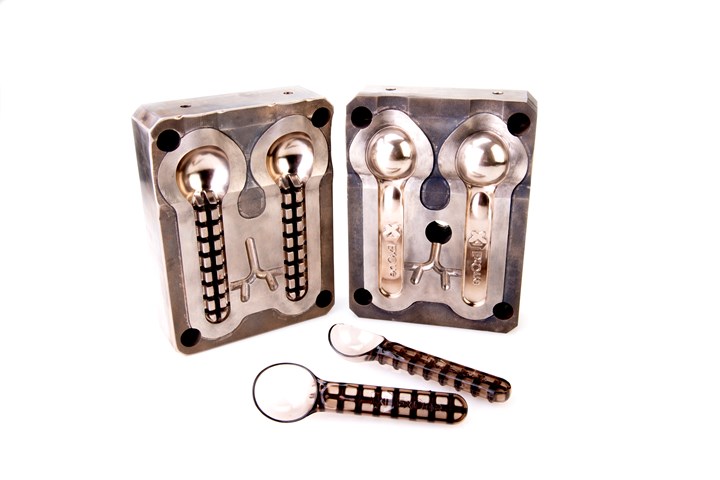Binder Jetting, Broad Tooling Portfolio Produce Efficient Inserts for Ice Cream Scooper Mold
ExOne partnered with North American Mold to 3D print X1 MetalTool inserts in 420i for the plastic injection molding of an ice cream scooper, with conformal cooling channels and 33% reduced gate-to-gate cycle time.

Polished ice cream scooper mold. Photo Credit: ExOne
Binder jetting technology from ExOne is offering users new options for high-volume production tooling at affordable prices. The company notes the portfolio it recently unveiled covering a broad range of tooling options for the final production of plastics, composites and metals. This includes X1 Thermoform for vacuum and foam molding, as well as X1 MetalTool for plastic injection or blow molding.
To showcase the benefits of the technology, ExOne partnered with North American Mold to 3D print X1 MetalTool inserts in 420i—a steel-bronze matrix material for durable and affordable inserts—for the plastic injection molding of an ice cream scooper. The whole process took less than two weeks from printing to the final molded part.
First, the insert tool was designed by ExOne partner North American Mold in Auburn Hills, Mich., before 3D printing and sintering at ExOne’s headquarters. The near-net shape print was finish machined and polished to 900 Ra before parts were run off the tool in food-safe polycarbonate material, lupilon S-2000R, provided by Mitsubishi Engineering-Plastics Corp.
According to ExOne, the design freedom of 3D printing enabled conformal cooling channels that closely trace the draw of the scoop and features on the back of the handle in the mold design for maximum efficiency. Cycle time on the Sumitomo Demag SE180EV-A offered a gate-to-gate cycle time reduction of 33%. In all, the binder jet 3D-printed tools were produced for about one-third the time and about half the price of a typical steel insert.
X1 MetalTool is also available in 316L stainless steel, M2 tool steel and other materials. This tooling can be finish machined, acid etched and polished to a diamond finish, and is currently ideal for complex inserts.
Related Content
-
3D Printing Technologies for Moldmaking Applications
3D printing technologies, from conformal cooling to complex mold building, are making an impact on the moldmaking industry, one innovation at a time.
-
The Benefits of Vertically Integrating Metal 3D Printing and Machining
Having 3D printing and machining within one organization enables Addman’s engineers to collaborate and consolidate so it can quickly make successful metal 3D-printed parts.
-
3D Printing Innovates Hot Runner Manifold Design
Metal 3D printing combined with a conventionally machined manifold block overcomes flow shadows on valve gates and offers faster color changes while providing closer system pitch centerlines between cavities.















